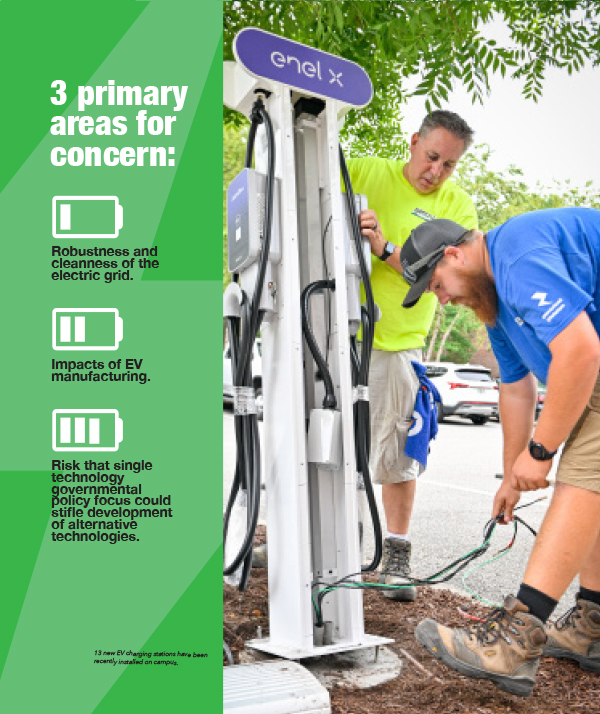
The electrification of ground transportation holds great potential to support society’s transition to a more sustainable transportation system. But, as with many technology trends, there are multiple constraints and side effects.
Although there is significant regional variation, the International Energy Agency (IEA) reports 14% of all new cars sold in 2022 were electric vehicles (EVs). In the U.S., 8% of new cars sold in 2022 were electric. Both globally and domestically, EV sales are expected to continue to grow significantly. The mix of battery-only EVs (BEVs) and hybrid EVs (PHEVs) varies by region as well, with BEVs now making up the majority of EV sales globally.
Systemically, the attraction of EVs is a potential reduction of point emissions (tailpipes) and a reduction in aggregate emissions from a more efficient, better managed electrical grid. This holds the potential for significant reductions in greenhouse gas emissions. And, if the electrical grid were to be transitioned to renewable energy generation, onward to a fully sustainable ground transportation system.
There are three primary areas for concern. These are the robustness and cleanness of the electric grid, the impacts of EV manufacturing, and the risk that single-technology governmental policy focus could stifle development of alternative technologies.
In the case of BEVs, the actual cleanness of operation depends heavily on the way in which the electricity used to charge the vehicle’s batteries is generated. Most existing developed nation grids operate most cleanly with normal power demand. When demand peaks, auxiliary production facilities are brought online, many of which are less environmentally friendly than the main generation facilities. That is, “peak clean energy supply” does not match with “peak energy demand” during the day.
In addition to the cleanness of energy generation, there is also the issue of general robustness or outright capability of the electrical grid. The recent example of state governments discouraging EV charging during episodes of prolonged high electrical demand provides an interesting caveat. Also, such noted automotive industry leaders as Elon Musk and Akio Toyoda have cautioned that overly rapid transition to BEVs could throw electrical grids into ongoing turmoil.
The manufacture of EVs is another area in which potential negative side effects to a rapid transition exist. Much of this arises from the global supply chain of “battery metals” (nickel, cobalt, etc.) required for the manufacture of common types of EV batteries. Most of these metals’ prices have soared in recent years, despite some recent moderation.
Globally, the current production and known reserves are distributed geographically in a way that can be seen both as politically dangerous for many Western nations and environmentally suspect. As the supply of key battery metals has been ramped up, attention has been drawn to the political realities of supplies from places such as the Democratic Republic of the Congo, along with the environmental impact of extraction techniques used in places such as Indonesia.
Efforts are underway to rely more heavily on alternate battery technologies such as lithium iron phosphate (LFP), which are less dependent on the “problematic” battery metals. However, thus far, these types have not provided the same range as the dominant nickel cobalt manganese (NCM) formulations. As an alternative, “solid state” EV batteries, which use a solid rather than liquid electrolyte, also hold the potential to change the EV battery landscape. But bringing solid state battery technology to relevant volumes currently appears problematic due to cost. So, for the near term, the issues surrounding battery metals will remain relevant for regions and applications where vehicle range is of high importance.

Finally, there appears at present to be a distinct preference for BEV technology as expressed in the governmental policies of many nations. This political overlay may inadvertently suppress the development of alternative technologies such as synthetic fuels, hybrid vehicles, and hydrogen fuel-cell technology that could prove useful in the evolution of the transportation system.
The geopolitics perspective complicates matters even more. As an example, recent U.S. legislation and regulation intended to encourage EV battery production in the U.S. significantly limited key EV tax credits based on source of components and assembly location of EV batteries. This, in turn, impacted the effective price of many of the most popular EV models in the U.S. market.
Our research into the impact of the global battery metals supply on the financial performance and health of EV manufacturers has led us to conclude that issues addressed here will continue to be important into the foreseeable future. Our hope is that all stakeholders will have a clear understanding of the key issues as we continue in our collective quest for a brighter energy future.


